Whether you use social media to promote your products and services or simply to build a personal brand, you should know how to conduct a successful social media audit.
With the number of social media users swelling up to 5.17 billion in 2024, the importance of having a strong social media presence cannot be understated, and it all starts with a social media audit.
However, the ever-evolving nature of social media and the introduction of new platforms like Threads and Bluesky, among others, on a regular basis can make the entire process quite overwhelming for anyone, especially beginners.
The good thing is that you can learn all the key aspects of social media audit in this guide. So, keep reading to learn what exactly a social media audit is and how you can conduct one.
What is a social media audit?
Unlike the tax audits, social media audit is not a scary or intimidating process. In simplest terms, a social media audit is a comprehensive process of analyzing the social media presence of any entity, such as an individual or an organization.
In other words, a social media audit means tracking, measuring, and analyzing the performance of social media profiles. These profiles can belong to any type of business brand, organization, or individual.
The results of a social media audit provide a clear picture of your present social media efforts and identify the most effective ways to improve them. When you’re done, you’ll have a single strategy document for all of your social media channels, complete with crucial details.
Some of the common social media metrics analyzed and tracked in a social media audit are:
- Post impressions
- Views
- Comments
- Likes/reactions
- Shares
- Other forms of interaction can vary from platform to platform.
The overall result of such analysis is useful in determining the target audience, demographics, engagement, and effective social media strategies to build a strong social media presence.
Example of a social media audit
Let’s take the example of Xiaomi, a popular Chinese electronics manufacturing company mainly known for selling smartphones, to understand better what a social media audit is. The brand has a strong social media presence across all major platforms, as shown in the following image:
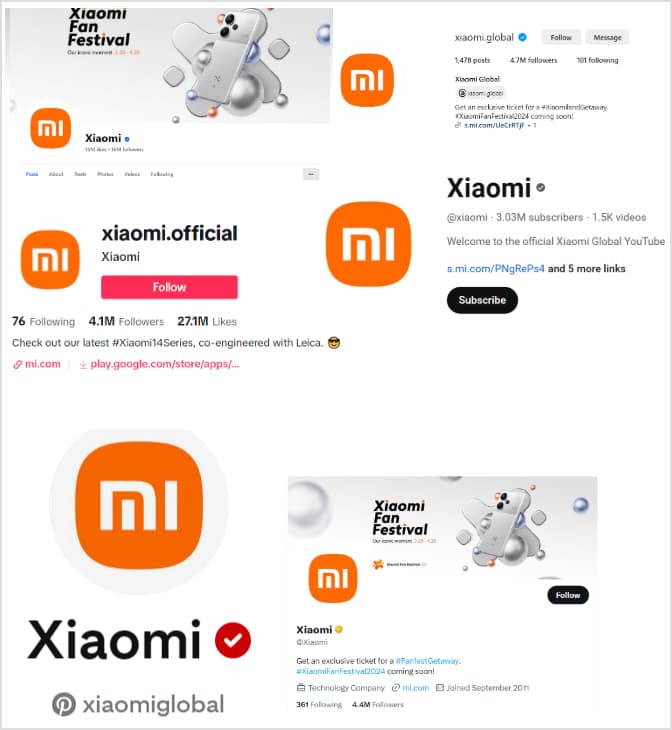
However, a careful look at these profiles shows that there are some inconsistencies, including:
- The company has varying official handles. For instance, “Xiaomi Official” on TikTok and on Pinterest and Instagram are simply ‘Xiaomi.’ It can confuse the audience, especially when trying to find the official social media page.
- The brand defines itself as an ‘internet company’ on Facebook and a ‘technology company’ on X, so there are branding inconsistencies.
- The upcoming ‘Xiaomi Fan Festival’ is not being promoted equally on every platform. Hence, it can lose out on reaching a significant audience, such as Gen Z, who mostly use Instagram and TikTok.
This is a basic example of a manual social media audit.
In the later sections, we’ll dive into the detailed types and examples of social media audits, so keep reading!
Summary: Social media audit template and checklist
Here’s the complete social media audit checklist you can follow to gather complete information about your social media profiles:
| Checklist item | Details |
|---|---|
| Platform’s name | List the social media platforms your brand uses (e.g., Facebook, Instagram, LinkedIn). |
| Profile URL | Include the direct link to each social media profile. |
| Profile name | Record the profile name or handle used on each platform. |
| Number of followers | Track the current follower count for every account. |
| Activity status | Note whether the profile is active, inactive, or duplicate. |
| Priority | Categorize profiles as high, medium, or low priority based on their importance to your strategy. |
| Post frequency | Evaluate how often posts are published (e.g., daily, weekly). |
| Engagement metrics | Analyze likes, comments, shares, and other platform-specific engagement data. |
| Profile completeness | Ensure bios, profile pictures, cover images, and contact details are up to date and consistent. |
| Fake accounts | Identify and note any fraudulent or duplicate accounts to be reported. |
| Brand messaging consistency | Verify if brand tone, visuals, and messaging are consistent across platforms. |
| Demographic data | Include key audience demographics such as age, gender, location, and interests. |
| Sentiment analysis | Record audience sentiment (positive, neutral, negative) based on mentions and posts. |
| Competitor benchmarks | Compare engagement, content strategy, and growth metrics with competitors. |
| SWOT analysis | Assess strengths, weaknesses, opportunities, and threats of your social media strategy. |
| SMART goals | Set specific, measurable, achievable, relevant, and time-bound goals to guide future efforts. |
Free social media audit template
Conducting a social media audit can seem like a lot of work. Therefore, ContentStudio intends to simply this process by providing a completely free social media audit template you can use to analyze and audit your social media presence.
You can view this social media audit template by clicking on the following link. If you want to edit the template, you ask for permission or simply download it.
9 steps to conduct a social media audit
Now that you have the social media audit checklist and the free template, let’s dive deep into how to do a social media audit.
While there is no one-size-fits-all approach, you can follow nine general steps to audit and analyze your social media thoroughly.
So, let’s discuss these steps one by one:
Step # 01 – Create a list of your social media accounts
Creating a list of your social media accounts is quite easy, right?
Well, not really. Here’s why.
You need to make a complete list of all of your active as well as inactive social accounts. Knowing the status of your current social media presence sets the very foundation of an effective social media audit.
So, start the audit by creating a complete list of your social media accounts.
Moreover, you might also have multiple or duplicate accounts on specific social media platforms. Most importantly, do not be shocked if you see fraudulent accounts running in your name. Note such accounts so suitable action can be taken against them.
Large-scale brands and enterprises with multiple departments and operations in different countries also tend to have multiple social media accounts. For example, Xiaomi is a global technology company that has separate profiles for the global brand and a separate one for location-specific branches, such as UAE:

You should always include all of these accounts and profiles in your list of social media accounts. This list will ultimately play an integral role in ensuring the success of the audit, so don’t rush the process.
A general social media audit checklist you can follow while creating a list of your social media accounts is:
- Platform’s name
- Profile URL
- Profile Name
- Number of followers
- Activity status
- Priority
- Post frequency
Once you have this complete data, you’ll be in a great position to eliminate fake or fraudulent accounts and focus on optimizing your real accounts.
Step # 02 – Report fake accounts
You would not want a third party or even a competitor spoiling your brand’s image on social media, right?
This is why you must report fake accounts early in the social media audit process. It ensures you can focus on your original social media accounts to reach your goals.
Once you have a complete list of your social media profiles, your next step should be to determine which ones are official and which are fake. This step is normally quick and easy for companies led by one person.
Here’s an example of reporting an impersonator on Facebook:
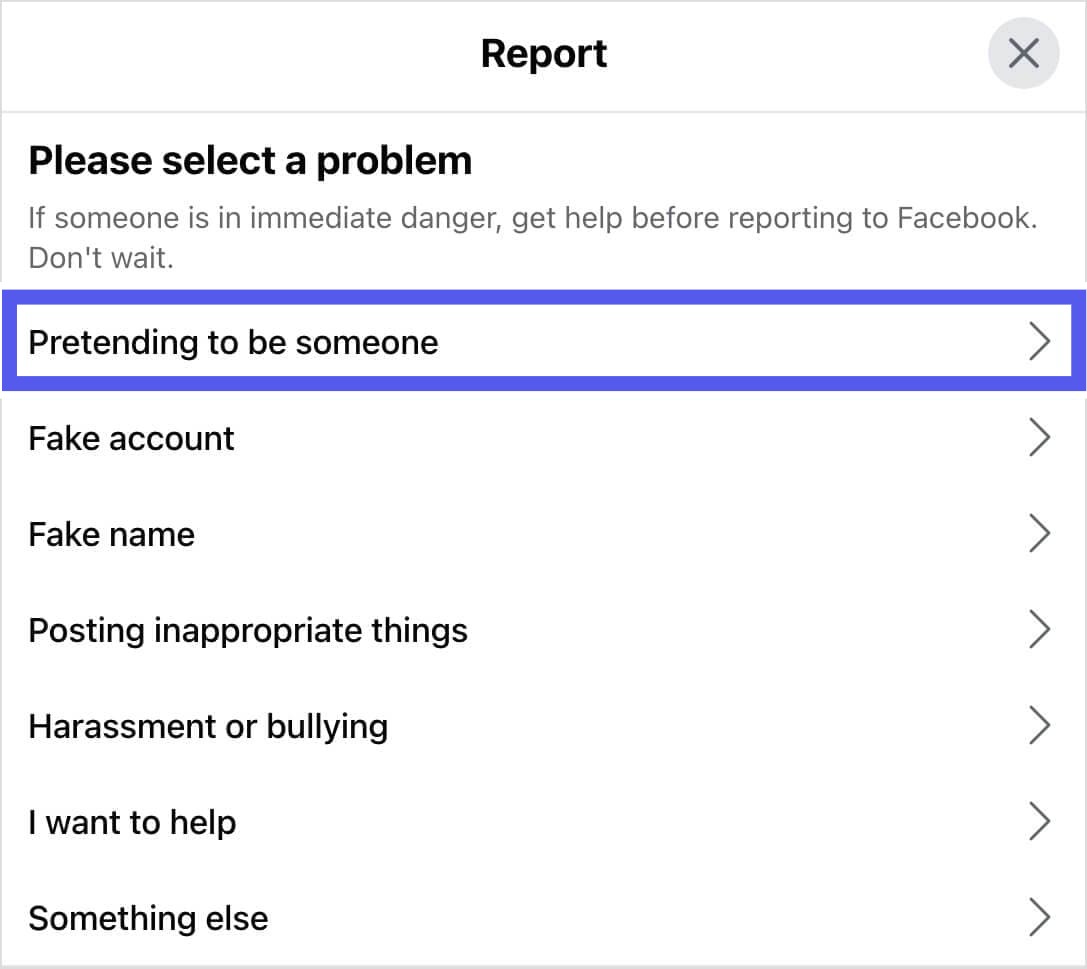
However, if multiple individuals or large teams are involved in social media efforts, it becomes important to establish the ownership of every account. Once you get familiar with fake or inactive duplicate accounts, report them.
Remember that having a strong online presence is all about bringing credibility to your brand and impressing the audience with engaging content.
So, don’t skip this step as part of your social media audit.
Step # 03 – Analyze social media engagement
Gone are the days when users had to analyze social media metrics manually and note them down in lengthy spreadsheets. Nowadays, all leading social media platforms have built-in analytics tools.
Here’s an example of Meta’s built-in analytics:
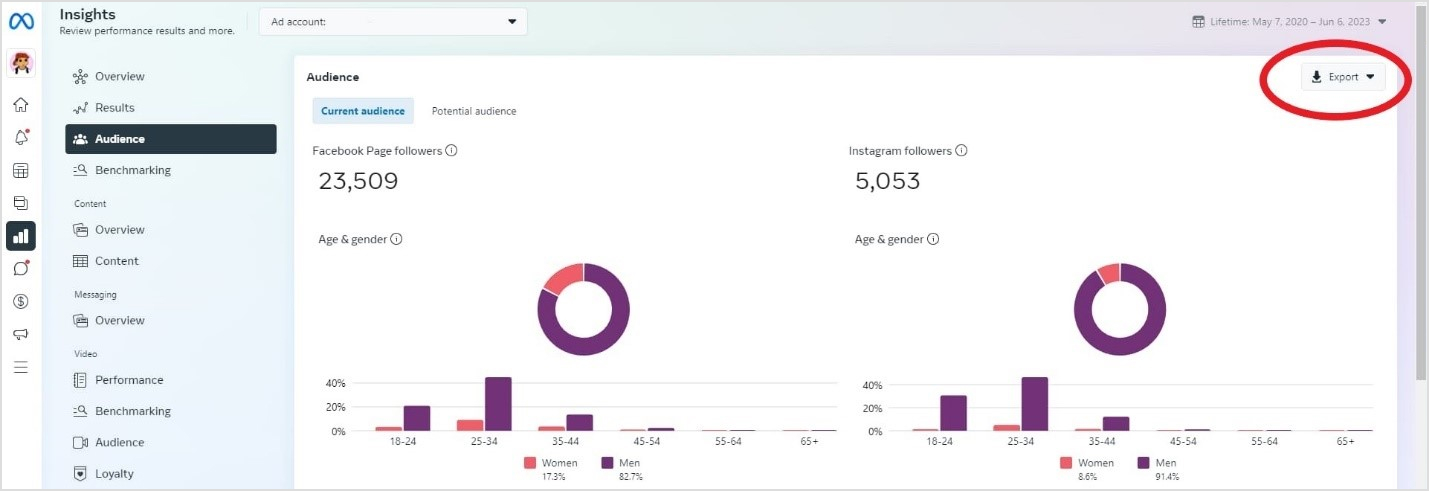
These analytics tools are useful in recording engagement metrics, demographics data, post-performance, impressions, visitors, and click-throughs.
These metrics are the core of any social media audit, so make sure you are analyzing and recording these metrics on all social media platforms. Here’s a closer look at how you can get information about key social media metrics from Instagram’s built-in analytical tools.
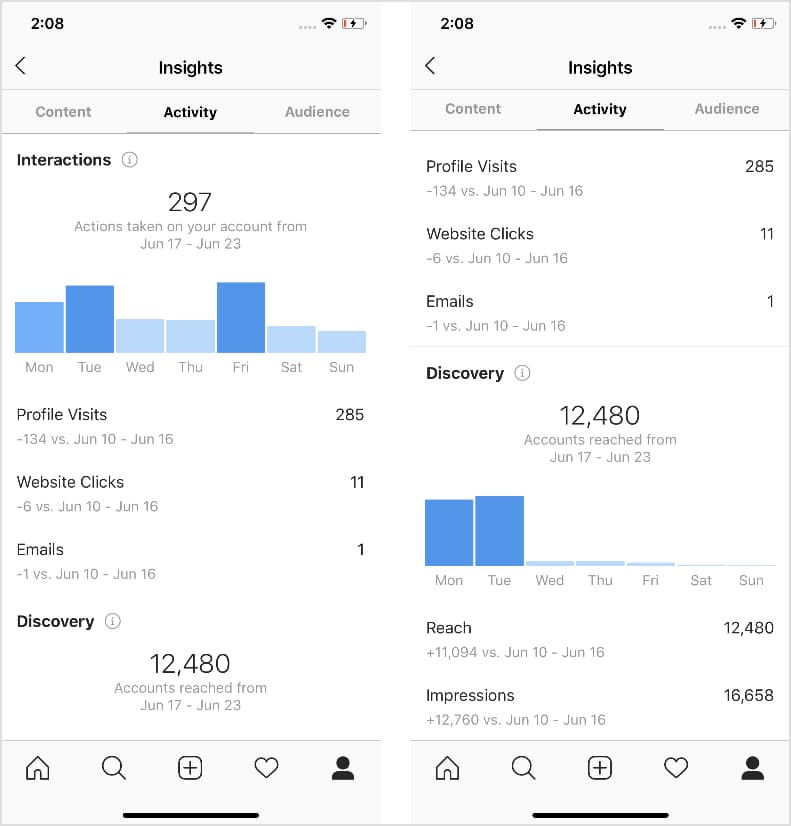
These native analytics features are useful to get only basic information about what’s working and what’s not. if you are looking for a comprehensive social media management tool with strong analytics and reporting features, you should be using ContentStudio.
It allows you to monitor and analyze social media performance across all platforms through a single dashboard without constantly switching screens between different built-in tools.
Social Media Analytics
Fine-tune your social media strategy for success with in-depth analytics and white-labeled reports.
Get Started for FREE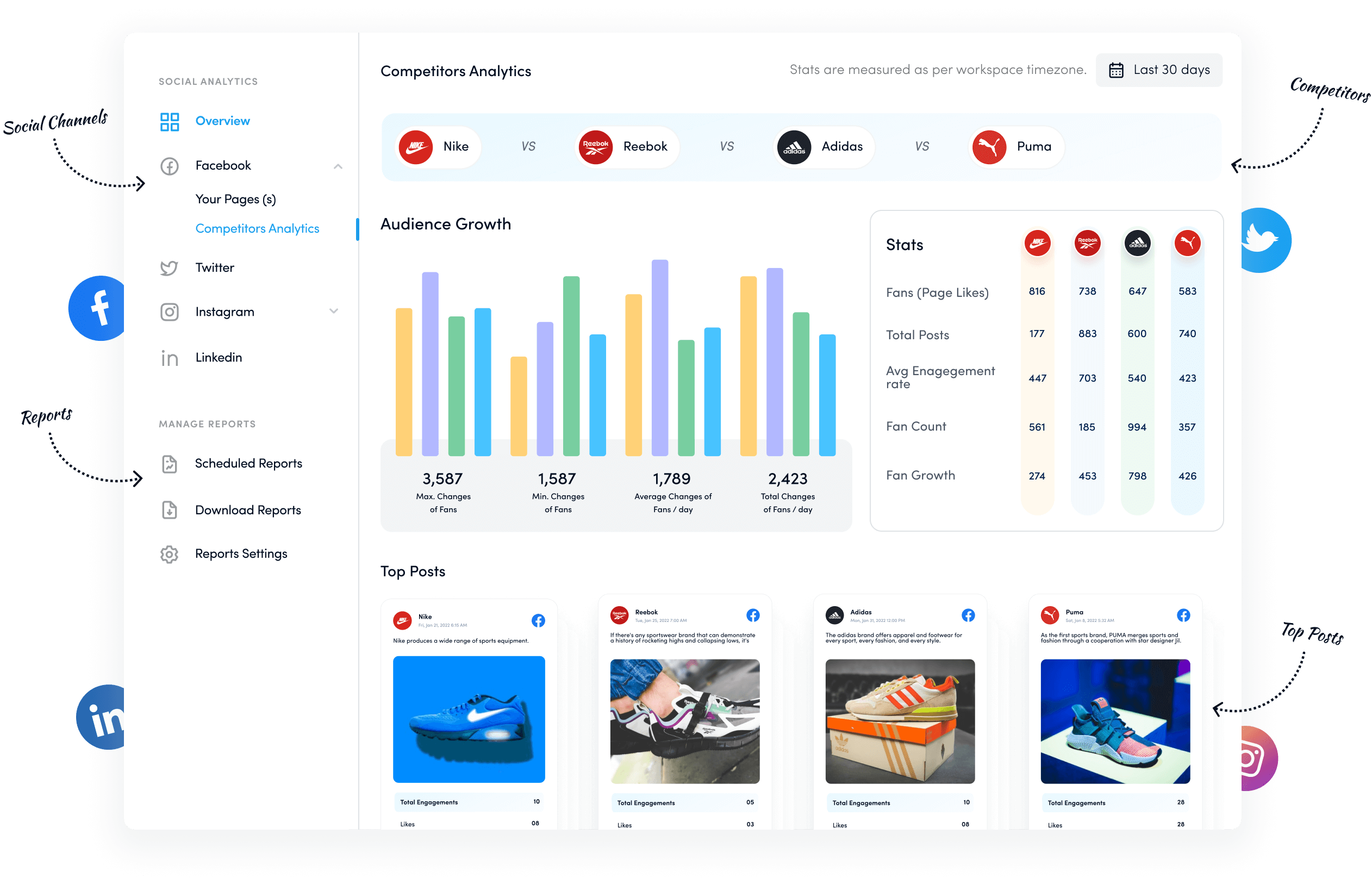
Step # 04 – Evaluate brand messaging
Once you are familiar with the present engagement level, you should analyze the quality of content on your social media profiles.
The metrics of each social media platform can vary, but the core of such analysis is to ensure your social media content is aligned with your brand’s messaging and goals.
Some key aspects involved in this step of the social media audit are:
- Check the name of your social media handles. Try to keep consistent names across all platforms to ensure quick and easy accessibility.\
- Examine the profile pictures and cover photos. Use properly sized images and ensure their optimization so your entire target audience can view them.
- Verify your accounts to bring more credibility and authenticity to your social media presence.
Related: How to get verified on Facebook?
- Update your bio section on all platforms to ensure accuracy and consistency. Add up-to-date information, including a brief introduction of your brand, vision statement, and business tagline.
- Update the contact information, if needed, and ensure you have entered the right address, phone number, website, and email on every platform.
- Pin the relevant and latest posts. It is always a good idea to pin posts that can quickly captivate the profile visitor and let them know what your brand truly stands for.
Step # 05 – Competitor analysis
Most people are aware of the importance of competitor analysis in different parts of life, such as before establishing a business, writing a blog, or launching a new product.
Yet, ignoring competitor analysis in social media audits is quite common. However, you should not make the mistake of skipping competitor analysis, as it can significantly impact the effectiveness of your social media audit.
The reason is simple: competitor analysis gives you certain benchmarks to compare your social media progress.
Analyze the social media profiles of leading brands and organizations in the same niche or industry.
Focus on obtaining the following metrics from your competitors:
- Engagement benchmarks that include average number of followers, comments, likes, and shares
- Type of content and publishing frequency
- Content ideas
- Growth level
- Performance of top posts
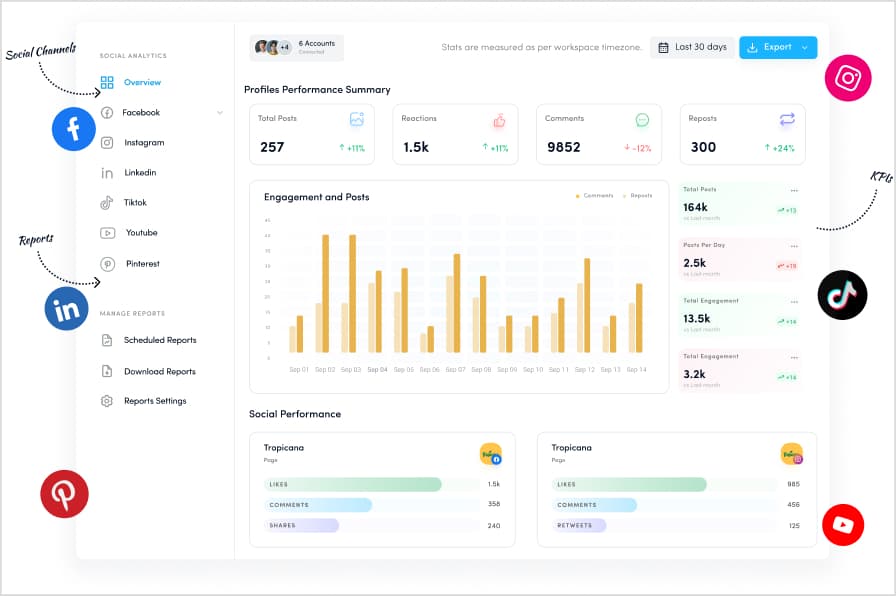
Collecting and analyzing all of these metrics manually from multiple competitors can be time-consuming, so it is recommended that you use a modern social media competitor analysis tool. In this way, you’ll be able to have a complete picture of your competitor’s social media strategy in no time.
Step # 06 – Analyze your demographic data
A major benefit of social media platforms is that they are available to people all over the world. Having a diverse following is always beneficial for brands.
Yet, if you don’t fully understand your target demographics, you can end up making mistakes that will hurt your brand. The following statistics from SmartInsights are just one example of how social media users differ from each other in terms of age groups.
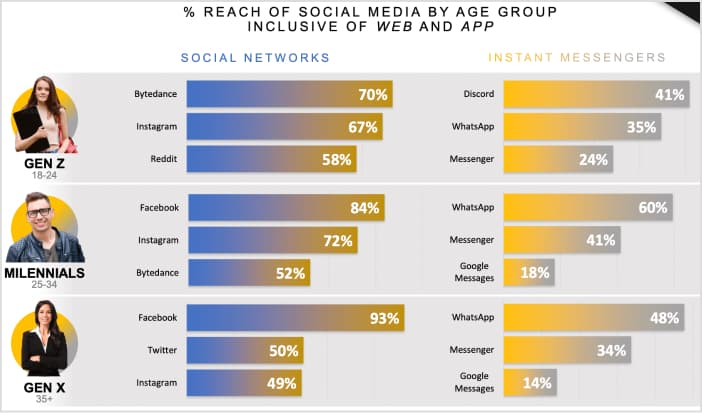
Knowing your audience demographics on each platform is essential to ensure you post relevant content in a suitable format, style, and language. This is important because there is a huge difference between Gen Z and millennials’ use of social media platforms.
For example, one study revealed that both Gen Z and millennials will continue expanding their social media presence until 2027. While TikTok, Snapchat, and Instagram are the most popular apps among Gen Z, millennials have the highest presence on apps like Reddit and Facebook.
Such statistics reveal the importance of including the age, gender, and interests of your target audience as part of your audience analysis. You can obtain such information from major social media platforms’ built-in demographic analysis tools.
The following image is an example of a demographic breakdown of a Facebook profile.
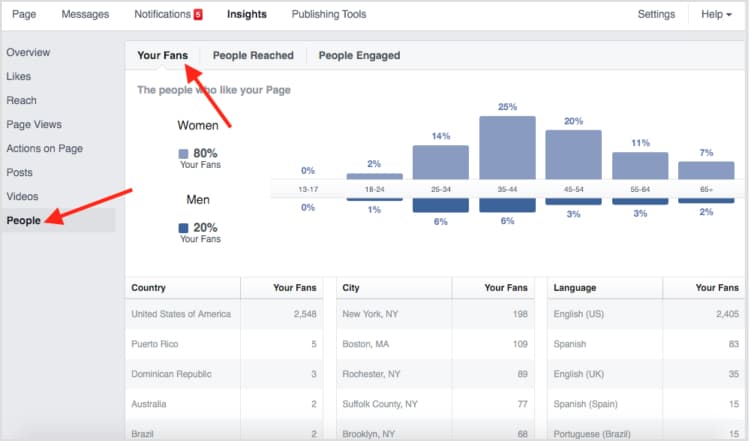
Step # 07 – Perform a sentiment analysis
A sentiment analysis is an effective way of determining what people are saying about your brand.
It is possible that your brand might be getting a high number of mentions online, but these mentions are not always a sign of positive social media presence. Instead, people might post negative things about your brand, which can cause significant damage to your reputation and profits.
Therefore, sentiment analysis is vital to evaluate how your audience perceives your brand and what they truly feel about it. Key things to track in a sentiment analysis are:
- Number of mentions and posts related to your brand
- Presence of positive or negative words in posts
- Type of emojis users are including in their posts relevant to your brand
Other than the posts specific to your profile, you can also analyze the trending topics and create posts based on the user’s sentiment. It is useful for brands to participate in community discussions and connect with a wider audience.
Related: Content intelligence and powerful insights
Step # 08 – Perform SWOT analysis
SWOT stands for Strengths, Weaknesses, Opportunities, and Threats.
Once you have collected ample data about your social media profiles, it is important to take a step back and thoroughly analyze them as per the principles of SWOT analysis.
As the name suggests, the purpose of a SWOT analysis is to evaluate the strong and weak areas of your social media profiles.
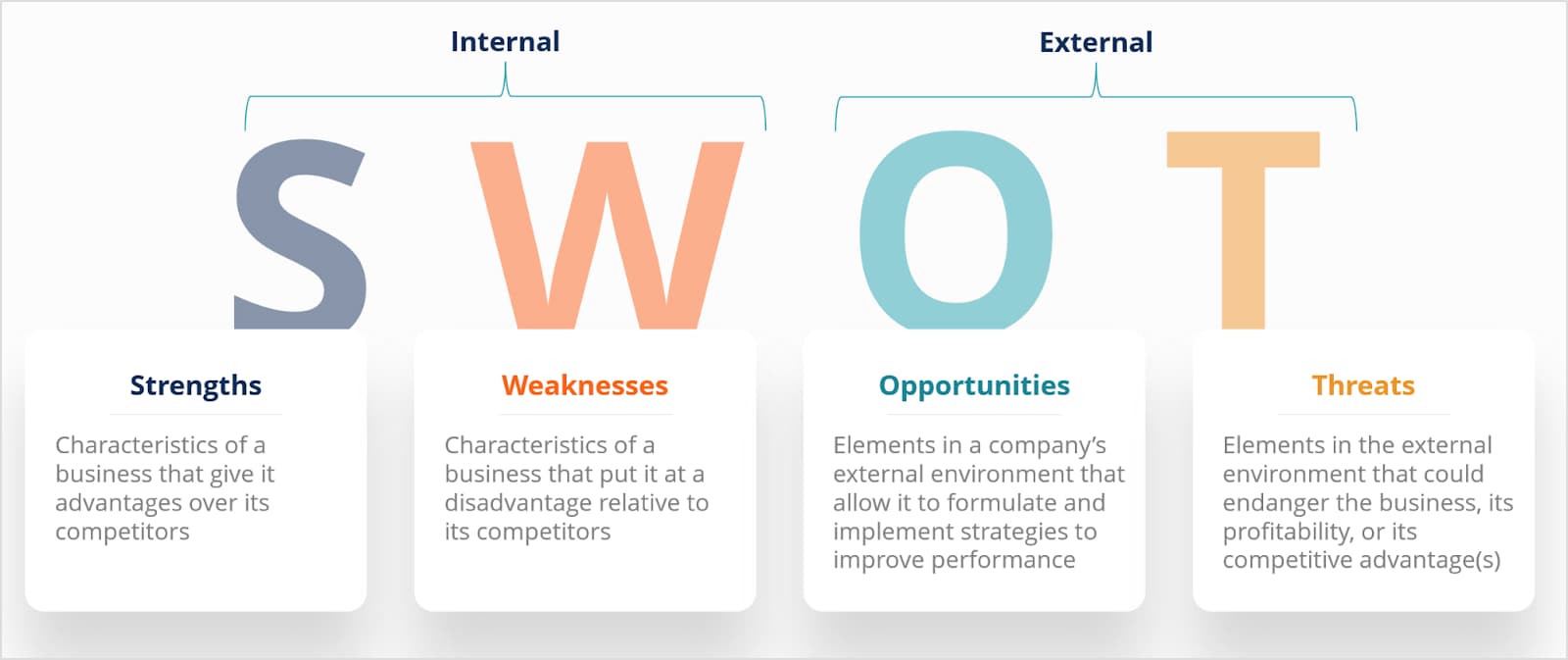
Moreover, it gives you an idea about new opportunities you can explore, such as a new social media platform or type of content you can target to expand your reach.
Finally, SWOT analysis example also helps you identify threats, such as fewer post frequencies or negative brand sentiment, that can impact your business.
Step # 09 – Set achievable SMART goals
The goal of a comprehensive social media audit is to evaluate the performance of your online presence.
So, once you have obtained all of the critical data through processes like engagement evaluation, competitor analysis, sentiment analysis, and SWOT analysis, the final step is to set new social media goals or adjust your old ones.
Take the time to fully understand the result of your social media audit and review your social media goals and objectives. Make sure you are setting achievable goals based on the current performance of your brand’s social media.
While there are various steps you can follow to set social media goals, an ideal way to do it is to make SMART goals. This means your social media objectives should be specific, measurable, achievable, relevant, and time-bound.
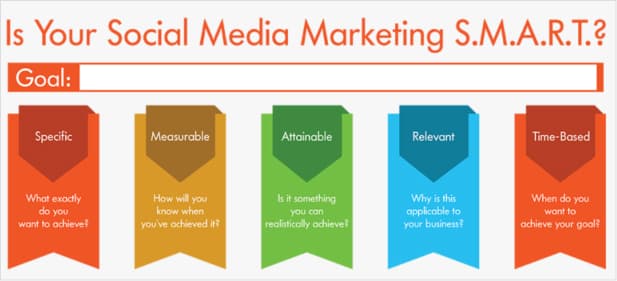
An example of a SMART social media objective is that if your social media audit report shows that the brand had a 3% increase in engagement rate from February to March, then you can set the goal of achieving a 3% or greater increase in the following months.
Similarly, these goals can also be relevant to specific social media platforms. For example, plans to create more reels for Instagram to drive engagement, revamp content language, and increase post frequency.
Other than the SMART goals specific to each social media platform, your overall social media goals can be:
- Enhance brand awareness
- Explore new audience insights
- Increase engagement through social media
- Generate more leads and ensure better conversion
Once you have set realistic and achievable social media goals, you can start working on achieving them. These goals serve as a great way to measure your progress in the next social media audit.
By following the above 9 steps, you shall have no problem in conducting
Benefits and importance of social media audit
A social media audit is essential for a social media strategy with a strong return on investment.
Many businesses overlook it as a crucial step, and as a result, they lose more money than they should through their social media marketing efforts.
There are various compelling reasons to do a social media audit, including the following:
- Examine your campaign’s execution to see where it falls short.
- You’ll be in a better position to enhance your execution if you understand its flaws and strengths.
- Discovering opportunities would have been overlooked if a social media audit had not been performed.
- Providing a favorable image of your brand to your prospects and customers.
- Determining what elements affect the core conversion rate and analyzing the success and failure of your social media campaign in terms of conversions.
- Knowing where you stand concerning your competitors can start employing strategies that they are overlooking.
A social media audit provides you with a level of clarity that you wouldn’t have had otherwise. It serves as a fantastic beginning point for improvement and removes any immediate roadblocks that may have been impeding your campaign’s progress.
A social media audit, like a major house cleaning project, makes your campaign cleaner and smarter.
Yes, carrying it out needs some work.
However, in the end, it will enable you to make a slew of little adjustments that will only serve to improve your social media marketing plan on a larger scale.
As a result, you’ll be able to create a favorable return on your investment in the long run.
Social media audit in a nutshell
Considering the multiple steps and procedures involved in a comprehensive social media audit, it is understandable why many businesses, brands, and individuals are not able to conduct an effective audit.
However, a social media audit doesn’t have to be complex or time-consuming. If you follow the procedures outlined in this article systematically, you may be able to complete yours in as little as 30 minutes.
Moreover, the benefits you can get after conducting an audit and optimizing your profiles are far greater than a few complications you might face in the process.
The good thing is that affordable and reliable tools like ContentStudio have streamlined the social media management and analytics process for all types of brands, agencies, and users.
Plan, schedule, share, and analyze content for 15+ social media channels.
Try ContentStudio for FREE
FAQs
A social media audit is the process of reviewing and analyzing a brand’s social media presence across various platforms. It includes measuring and tracking performance metrics to identify optimization opportunities and improve engagement on social media platforms.
You can conduct a comprehensive social media audit by following these steps:
1 – Collect complete details of your social media profiles
2 – Analyze performance and engagement metrics
3 – Evaluate brand messaging across platforms
4 – Perform competitor analysis and dig into your demographics
5 – Determine the overall sentiment about your brand
6 – Perform a SWOT analysis
7 – Set achievable and SMART goals
You should perform a social media audit on a quarterly basis. Basic audits can also be performed monthly, but it all comes down to your specific goals and how much resources you can allocate towards the auditing process.
When conducting a social media audit, the first step is to collect the name, URL, and basic information of all of your social media profiles.
Yes, you can audit your social media on your own without any tools. However, you’ll have to allocate significant time and energy towards this process. You will have to check the analytics of each platform one by one and manually generate a social media audit report. Unlike in a social media auditing tool, you won’t have a single dashboard to analyze and audit all platforms.
You can audit your social media for free by manually analyzing your profiles on all platforms individually. Visit all your social media profiles one by one and check analytics, including engagement, likes, shares, comments, number of followers, and views. Moreover, each social media platform’s publishing frequency and time should be evaluated.
